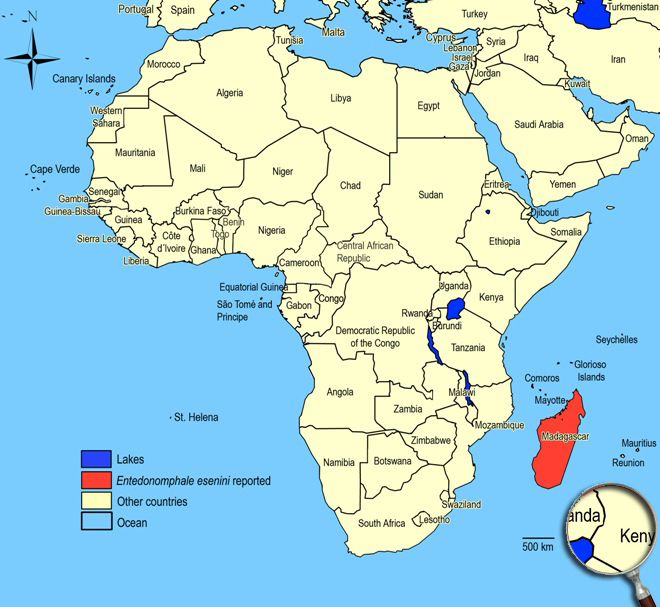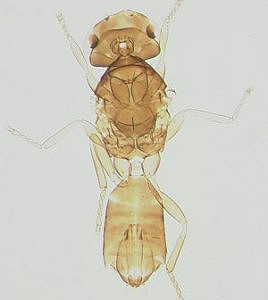Entedonomphale esenini Triapitsyn, 2005
Entedoninae, Eulophidae, Chalcidoidea, Hymenoptera
Figures
Fig. 1: Head, mesosoma and metasoma, dorsal
Fig. 2: Antenna
Fig. 3: Funicle segments and clava of antenna
Fig. 4: Funicle segments
Fig. 5: Head dorsal with vertexal suture
Fig. 6: Mesosoma dorsal with mesoscutum and scutellum
Fig. 7: Fore wing
Fig. 8: Metasoma
Fig. 9: Petiole
Introduction and recognition
Entedonomphale esenini is a larval endoparasitoid of thrips belonging to the family Phlaeothripidae (Tubulifera), but hitherto the host species are unknown. Female: length <1 mm. Body brown, appendages mostly light brown (Fig. 1). On head vertexal suture distinct, angulate; frontal grooves extending to the top of the eye (Fig. 5); malar sulcus split ventrally (Y-shaped). Antenna with scape slender, about 4.0 x as long as wide; 2 funicle segments F1 and F2 subequal, about as long as wide and each with several sensilla; solid clava small, a little longer than funicle, about 1.9 x as long as wide, with several sensilla, but without an apical spicula (Fig. 2, 3, 4). Mesosomaa little shorter than gaster, smooth; midlobe of mesoscutum with 1 pair of setae; anterior margin of scutellum angulate (Fig. 1, 6). Fore wing broadened beyond submarginal vein, about 3.0 x as long as wide; longest marginal setae 0.45 x maximal fore wing width; disc completely hyaline, without a dark spot or band, more or less evenly setose in apical half of fore wing (setae moderately long), bare in basal half (Fig. 7). Hind wing about 6.0 x as long as wide; disc hyaline and with a few scattered setae; longest marginal setae almost equal to hind wing width. Hind coxa smooth. Petiole conspicuous, almost as wide as long (Fig. 9). Ovipositor occupying about 1/2 length of gaster, not exerted; ovipositor length/metatibia length ratio about 1.1:1 (Fig. 8). Male unknown.
Taxonomic identity
Species
Entedonomphale esenini Triapitsyn, 2005
Taxonomic history
-
Present taxonomic position
Order: Hymenoptera
Superfamily: Chalcidoidea Latreille, 1817
Family: Eulophidae Westwood, 1829
Subfamily: Entedoninae Förster, 1856
Genus: Entedonomphale Girault, 1915
Genus description
The Genus Entedonomphale Girault, 1915
This genus comprises about 14 described species. All known species of Entedonomphale are solitary, internal parasitoids of the larval stages of various Phlaeothripidae (Tubulifera), and have a Palearctic, Nearctic or Australian distribution. All species of this genus have the following features: Body usually brown to dark brown or black; head with a occipital suture usually evident (can be straight or angulate) but sometimes inconspicuous; frontal grooves extending to the top of the eye; malar sulcus split ventrally (Y-shaped) in most species, rarely straight; mandible reduced and without teeth; antennal scape in both sexes often notably expanded in basal half and narrowing distally; flagellum of female antenna with 2 funicle segments and a solid clava without an apical spicula; male flagellum either with a 2-segmented funicle and a 3-segmented (or rarely solid) clava or with a 3-segmented funicle and a solid clava, clava of male antenna with or without an apical spicula; notauli indistinct; midlobe of mesoscutum with 1 or 2 pairs of setae; anterior margin of scutellum usually angulate (projecting forward into mesoscutum) but sometimes sinuate or almost straight; fore wings broadened beyond submarginal vein, stigmal vein often (but not always) relatively far away from wing´s apex; longest marginal setae at most equal to (usually much less than) width of fore wing; metasoma obviously petiolate, petiole at least as long as wide, often notably longer than wide (Schauff 1991; Triapitsyn 2005). Triapitsyn (2005) gave a world taxonomic revision of Entedonomphale and three other related entedonine genera of thrips parasitoids, Loomans & van Lenteren (1995) provided an overview of the described thrips parasitoids and their importance for biological control of thrips pests, under the synonymy Entedonastichus.
Species description
Typical character states of Entedonomphale esenini
Body colour
Uniformly light to dark brown
Antennae
Funicle segments F1 and F2: subequal
Sensilla of funicle segments: each segment with several short sensilla
Length of funicle segments: about as long as wide or wider than long
Clava of female: not segmented
Apical spicula of clava: absent
Length of clava: a little longer than funicle, about 1.9 x as long as wide
Head
Vertexal suture: angulate (broadly Y-shaped)
Frontal grooves: reaching eyes above level of median ocellus, sometimes ending in vertexal suture
Mesosoma
Number of setal pairs on midlobe of mesoscutum: 1
Anterior margin of scutellum: distinctly angulate
Wings
Shape of fore wing: broadened beyond submarginal vein
Length of fore wing: 2.4 to 3.0 x as long as wide
Length of fore wing marginal setae: usually much less than width of fore wing
Longest marginal setae of fore wing: about 1/2 maximal width of fore wing
Fore wing disc: more or less evenly setose in apical half and bare in basal half
Colour of fore wing disc: completely hyaline, without pigmentation
Metasoma
Colour of gaster: completely light to dark brown
Petiole:
about as wide as long or longer than wide

Similar or related species
Entedonomphale lermontovi differs from Entedonomphale esenini in having the both antennal funicle segments each with 1 sensillum, antennal clava distinctly longer than funicle and about 2.4 x as long as wide, midlobe of mesoscutum with 2 pairs of setae, fore wing about 3.7 x as long as wide, and fore wing disc with slight brown pigmentation behind marginal vein. Whereas E. esenini has the funicle segments each with several sensilla, the clava is only a little longer than funicle and about 1.9 x as long as wide, midlobe of mesoscutum has only 1 pair of setae, the fore wing is about 3.0 x as long as wide, and fore wing disc completely hyaline and without pigmentation.
Entedonomphale and other genera differs from Goetheana by the shape of the antennal funicle segments (in Goetheana funicle segment F1 much smaller than F2, F2 almost fused with clava; in other genera the funicle segments F1 and F2 are subequal), the shape of the fore wing (narrow and recurved below the submarginal vein in Goetheana; species of the genera Entedonomphale, Ceranisus and Thripobius with fore wings broadened beyond submarginal vein), and the length of marginal seta of fore wing (in Goetheana the longest marginal setae much greater than width of fore wing; other genera with longest marginal setae at most equal to width of fore wing, but usually much less than width of fore wing). The chaetotaxy of the fore wing disc differs in the genera: in Goetheana the setae commencing beyond base of marginal vein and scattered in 2 or 3 broken rows toward the apex of the wing, in Entedonomphale the fore wing is evenly setose in apical half and bare in basal half, and in Ceranisus and Thripobius the fore wing is uniformly setose beyond base of marginal vein except for a bare area at posterior margin behind base of marginal vein, which is demarcated anteriorly by a sinuate or straight line of setae. Compared to Entedonomphale, species of Ceranisus and Thripobius have the antennal clava of females distinctly segmented (Thripobius with 3-segmented and Ceranisus with 2-segmented clava), and the apical spicula of clava ist present. Whereas in Entedonomphale the antennal clava of females is unsegmented and without apical spicula.Entedonomphale as well as Thripobius have an inverted Y-shaped malar sutures (in Ceranisus entire and straight).
Biology
Life history
Unknown.
Major host genera/species
Unknown.
Biological control
Not frequently observed.
Additional notes
-
Biogeography
Africa. Madagascar.
African countries where Entedonomphale esenini has been reported

The species Entedonomphale esenini was not observed in surveys undertaken in East Africa on vegetables and associated weeds and crops.
Please click here for survey sites of all observed thrips species of Kenya, Tanzania and Uganda.

Bibliography
Bouček Z (1976). Taxonomic studies on some Eulophidae [Hym.] of economic interest mainly from Africa. Entomophaga. 21 (4): 401-414
Gibson, G.A.P., Read, J.D. & Fairchild, R. 1998. Chalcid wasps (Chalcidoidea): illustrated glossary of positional and morphological terms
Loomans AJM & van Lenteren JC (1995). Biological control of thrips pests: a review on thrips parasitoids, pp. 89-201. In Loomans AJM, van Lenteren JC, Tommasini MG, Maini S & Riudavets J [eds.], Biological control of thrips pests. Wageningen Agricultural University Papers, 95-1. Veenman Drukkers, Wageningen, The Netherlands
Schauff M (1991). The Holarctic genera of Entedoninae (Hymenoptera: Eulophidae). Contributions of the American Entomological Institute. 26 (4): 1-109
Triapitsyn SV (2005). Revision of Ceranisus and the related thrips-attacking entedonine genera (Hymenoptera: Eulophidae) of the world. African Invertebrates. 46: 261-315
Triapitsyn SV, Boyadzhiev PS & Antonov AK (2008). Taxonomic notes on Entedonomphale (Hymenoptera: Eulophidae). Zootaxa. 1816: 61-64
----
Web links
BMNH, Universal Chalcidoidea Database
UC Riverside - Key to the Nearctic genera of Eulophidae
Mound´s Thysanoptera pages
Thysanoptera Checklist
ICIPE Thrips survey sites
UNI Halle & Thrips sites
Thrips of California
Chalcid wasps (Chalcidoidea): illustrated glossary of positional and morphological terms
Assembling the Tree of Life - Hymenopera Glossary












